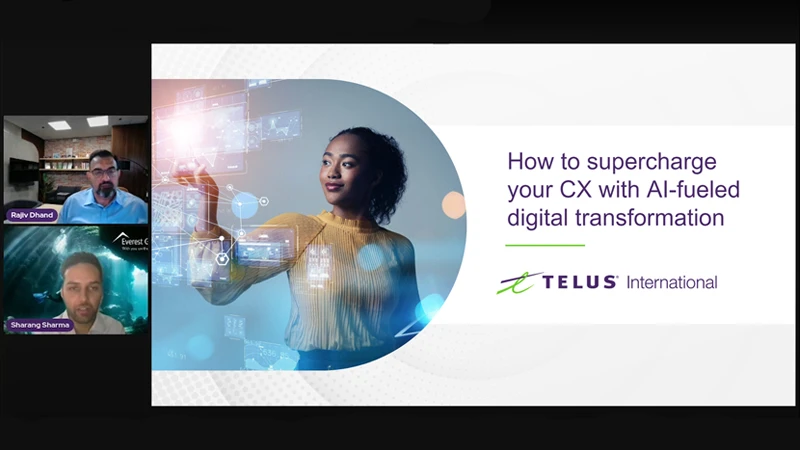How technology is revolutionizing telecommunications billing

Picture this: A customer logs into their banking app and notices that the automatic payment to their communications service provider (CSP) is significantly higher than usual. Confused, they jump over to the provider’s app, download the latest bill and start digging. The charges seem off — perhaps an expired promotion or a roaming fee gone wrong — but the bill is dense, full of codes and line items that don’t clearly explain the cost. With no clear resolution, the customer does what many in their shoes would do: they contact customer service.
This kind of billing frustration isn’t rare and it’s often a sign of outdated, inflexible systems struggling to support the modern services offered by CSPs. As pricing models grow more complex and digital offerings expand, legacy billing systems are being pushed to their limits. In response, CSPs are making significant investments in modernizing their business support system (BSS) and operations support system (OSS) environments — with global spending on software and services expected to reach USD $80 billion by 2028, according to Analysys Mason.
This transformation marks the need for greater operational agility — and that starts with rethinking how telecommunications providers bill their customers.
Turning billing challenges into transformation opportunities
Billing isn’t just an administrative task, it’s the core engine of a CSP’s revenue model. Whether customers are purchasing data, voice, broadband or digital add-ons, billing systems ensure transactions are recorded accurately, charges are applied correctly and payments are processed efficiently.
Legacy systems, however, often introduce friction to the billing experience. In fact, according to the 2021 RAG Digital Trust Survey, communications providers lost the equivalent of 2.92% of revenues in 2020 due to non-fraud-related errors and mistakes, underscoring the financial impact of outdated processes.
Today’s landscape presents an opportunity to reframe billing as a strategic advantage. By modernizing OSS/BSS environments, CSPs can unlock new levels of operational efficiency, reduce revenue leakage and enable more customer-centric innovation.
Revenue protection and optimization
Billing platforms need to go beyond static rule-based checks, leveraging technology and AI to proactively identify errors before they reach the customer. For example, if a promotion is misapplied by a call center agent, an intelligent system can flag the issue, recommend a fix or even automate the correction, all before the bill is finalized. This precision improves billing accuracy and reduces revenue leakage.
Fewer billing errors also mean fewer customer support calls, faster resolutions and fewer goodwill credits, which directly lowers costs.
Operational efficiency gains
One immediate benefit of modern billing systems is the ability to accelerate billing cycles through real-time or near-real-time processing. Instead of relying on rigid, batch-based invoicing models that delay revenue recognition, modern platforms offer faster, more accurate billing — improving cash flow visibility and allowing for more agile financial planning.
They also support complex pricing models, including dynamic usage-based rates, time-limited promotions and custom service bundles. Flexible billing logic enables CSPs to tailor offerings to market demand — something legacy systems with hard-coded rules and manual configurations struggle to achieve.
Additionally, by unifying siloed systems and automating manual handoffs, modern platforms reduce errors and speed up time-to-market for new services. Teams can work more efficiently, with fewer dependencies and less risk of human error, allowing CSPs to launch and iterate on offerings at the pace the market demands
Scalability and innovation enablement
As customer demands evolve and CSPs expand their offerings, the ability to scale operations and launch new services quickly becomes a competitive necessity. Modern billing platforms are designed with this agility in mind, enabling providers to grow their customer base, onboard new partners and launch additional service lines without the constraints of legacy infrastructure.
Stronger compliance and security posture
As regulations grow more complex, modern billing platforms give telecom providers the tools they need to stay compliant and secure. Designed with transparency in mind, they support accurate charge reporting, clear billing structures and timely dispute resolution — all of which reduce the risk of non-compliance and strengthen customer trust.
Security is another key benefit. Unlike legacy platforms, modern billing solutions use up-to-date encryption standards, secure APIs and advanced access controls to protect sensitive data. Built-in support for evolving privacy regulations, like GDPR and other industry mandates, makes it easier for CSPs to maintain compliance while remaining agile.
Improved customer experience and trust
Billing is one of the few consistent, direct touchpoints customers have with their CSP — and it’s a high-stakes one. Confusing, delayed or inaccurate invoices can erode trust and lead to costly support interactions or churn. On the other hand, a clear, timely and accurate billing experience reinforces credibility and strengthens the customer relationship.
Modern billing systems help achieve this by simplifying bill structures and presenting charges in an intuitive, easy-to-understand format. This reduces frustration and speeds resolution when issues arise — leading to more positive customer interactions. In a competitive market where switching providers is easy, a seamless billing experience becomes a powerful differentiator.
Realizing these benefits requires a technology-driven reinvention of billing operations. But large-scale transformation is rarely straightforward. Consolidating siloed systems and replacing aging infrastructure is a complex, time-consuming journey. For CSPs exploring modernization, a more strategic, incremental approach may be the most practical path forward — one that selectively modernizes high-impact capabilities first. This allows for meaningful improvements in the short term, while gradually laying the foundation for more extensive modernization over time.
The technology that is modernizing telecommunications billing
Today’s leading CSPs are turning to advanced technologies to unlock the speed, intelligence and flexibility that legacy billing platforms lack. Here’s a closer look at some of the tools and technologies driving this transformation.
Artificial intelligence and machine learning
AI and machine learning are transforming billing from a reactive, rules-based process into a proactive, intelligent system. In BSS environments, AI-enabled anomaly detection can identify issues like misapplied discounts or inconsistent usage charges in real time — minimizing disputes and revenue loss. In OSS environments, these technologies analyze real-time network performance data to predict service disruptions, automate fault detection and optimize maintenance schedules — improving reliability and reducing operational costs.
At the same time, ML models trained on network and billing data can surface suspicious activity patterns that traditional systems may overlook, strengthening fraud detection and prevention, as well as compliance. This is a critical capability in an industry where fraud remains a significant threat. According to the Communications Fraud Control Association, the telecom industry lost an estimated $38.95 billion to fraud in 2023, representing 2.5% of global revenues.
AI and ML also power real-time personalization. By analyzing usage patterns and customer preferences, CSPs can deliver customized plans, upsell offers and time-sensitive promotions. The business case for personalization is compelling: Research by McKinsey shows that operators who fully leverage analytics and data-driven personalization for customer value management can increase revenues by up to 10%, while boosting customer satisfaction and engagement by 20-30%. Yet, only about 5% of telcos have tapped into this full potential — leaving a significant opportunity for competitive advantage.
Generative AI
Generative AI (GenAI) builds on traditional AI with powerful natural language capabilities. Trained on telecom-specific data, GenAI can help both BSS and OSS systems interpret complex data and take meaningful actions.
In BSS environments, GenAI-powered virtual assistants go far beyond answering basic FAQs. They can interpret detailed invoices, clarify ambiguous charges, resolve disputes and even initiate corrective actions — all without involving a live agent. Internally, GenAI acts as a co-pilot for billing teams, flagging anomalies, recommending fixes and assisting with compliance documentation or regulatory reporting. Over time and with enough training, it can help automate repetitive quality assurance tasks, further improving billing accuracy and operational efficiency.
Communication service providers are already seeing the strategic value of these capabilities. According to NVIDIA’s State of AI in Telecommunications: 2024 Trends report, 43% of telecom respondents are already investing in GenAI. Among those, 57% are using it to enhance customer service and support, and another 57% are focused on boosting employee productivity.
But the benefits of GenAI extend beyond billing and customer service. In OSS environments GenAI is enabling smarter, faster network operations. In the aforementioned trends report, NVIDIA found that 48% of telecoms investing in AI are using GenAI for network operations and management, while 40% are using it for network planning and design. GenAI can analyze real-time network performance data to detect network anomalies, predict outages and trigger self-healing capabilities that restore service automatically. It also supports long-term planning by forecasting demand, simulating infrastructure requirements and aligning network upgrades with business objectives — helping CSPs reduce downtime, optimize resources and better serve customers.
Cloud
As billing becomes more dynamic, the cloud provides the speed, scalability and flexibility needed to keep up. Cloud-native BSS platforms support real-time billing, continuous charging, flexible pricing and on-demand invoicing.
They also simplify integration. With open APIs and modular architecture, CSPs can quickly connect third-party tools — such as customer data platforms, fraud detection engines or analytics dashboards — without lengthy development cycles. This flexibility speeds up innovation and enables CSPs to adapt their billing ecosystems to new service models, pricing strategies and customer expectations.
Scalability is another key advantage of the cloud. As CSPs grow their subscriber base and introduce new digital services, cloud infrastructure scales effortlessly to meet rising demands, eliminating the bottlenecks common in legacy systems. Additionally, real-time data sharing across platforms helps unify customer and billing insights, leading to more consistent, personalized experiences across every touchpoint.
On the OSS side, by tapping into real-time network performance data, cloud-enabled OSS environments can help automate service provisioning, detect faults faster and enable predictive maintenance — key enablers for rolling out complex services like 5G and IoT more efficiently.
Take a major American telecommunications and mass media company for example. The company was preparing to launch a new line of business, but its aging tech stack stood in the way. With billing operations tied to on-premise data centers and limited by vendor lock-in, the company struggled to integrate new third-party tools and lacked the flexibility to support new services.
To overcome these challenges, they collaborated with TELUS Digital. Our experts helped migrate their infrastructure to the cloud and implement open API standards, creating a more modular, future-ready billing environment. This shift enabled smoother data exchange across platforms, made it easier to connect with external tools and eliminated many of the constraints imposed by its legacy systems.
As the company rolled out its new services, the benefits of cloud scalability became clear. Cloud infrastructure allowed them to scale usage and capacity as needed — without costly upfront investments. It also helped unify the customer experience by breaking down internal silos, making it easy for existing customers to add the new service to their accounts through a single, integrated billing platform.
Within five years, these improvements helped the company add more than 1 million customers to their new line of business.
Automation
Within BSS, robotic process automation (RPA) and workflow orchestration tools are being used to automate structured, rule-based tasks such as invoice generation, billing adjustments, reconciliation and dispute resolution. Unlike GenAI or machine learning — which handle unstructured data and adapt to more complex scenarios — RPA focuses on repetitive processes with clearly defined inputs and outputs. By offloading these routine tasks, CSPs can improve billing accuracy and compliance while freeing up teams to focus on higher-value work.
Automation can also deliver significant cost and productivity benefits. For example, one major North American telecommunications provider partnered with TELUS Digital to improve agent access to billing data during live customer interactions. Previously, agents had to manually navigate a separate billing system — a time-consuming and error-prone process. Our team performed the data modeling needed to create a custom internal database that mirrored key billing information. Process automation was then implemented to automatically sync data between the billing platform and the new database. The result was a streamlined process that gave agents instant access to customer information, reducing call times by 30%, improving resolution rates and lowering support costs by approximately 50%.
In OSS environments, automation helps ensure service reliability and performance by streamlining key operational tasks. For example, automated scripts can continuously monitor network activity, detect anomalies like dropped connections or latency spikes, and trigger real-time alerts or remediation actions without human intervention. Intelligent provisioning tools can automatically configure services when a customer signs up, while self-healing workflows can reroute traffic or restart failing components to prevent outages. By reducing manual involvement in these processes, automation supports the consistent delivery of services, which, in turn, ensures billing systems accurately reflect what customers use.
Without investing in modernizing their billing operations, CSPs risk falling behind more agile competitors who are already using their billing stack as a lever for growth. The opportunity isn’t just to fix inefficiencies — forward-thinking providers are turning billing into a strategic asset. And for many, the fastest path to that future is through the right technology partner.
Powering the next era of telecommunications billing — with the right partner
Modernizing telecom billing is a complex, high-stakes undertaking that requires the right combination of technology, talent and experience. As CSPs strive to deliver more dynamic, personalized and intelligent billing experiences, many are recognizing the value of working with trusted partners to accelerate transformation.
Outsourcing providers bring deep industry knowledge, robust technology stacks and proven expertise in emerging tools. This support is especially critical at a time when internal teams face resource constraints. For example, AI continues to evolve at a breakneck pace, and lacking access to the latest technologies or expertise can leave CSPs at a disadvantage. In fact, 32% of respondents in the aforementioned NVIDIA report said they worry about being industry laggards in their AI capabilities.
To address this, many CSPs are prioritizing partnerships. Respondents cited working with third parties to accelerate AI adoption as their top area of AI-related investment. This highlights a demand for collaborators who can help CSPs deploy, integrate and scale a full spectrum of technologies to modernize billing systems and unlock greater agility, efficiency and customer value.
TELUS Digital is already helping shape the future of telecom billing. We have partnered with Amdocs to solution an AI-powered billing QA and anomaly detection capability as part of a catalyst project at TM Forum’s DTW Ignite. This initiative applies GenAI to predict and detect billing issues in real time to help mitigate revenue leakage and improve customer satisfaction. By bringing greater accuracy and transparency to billing, our team is helping to deliver peace of mind for both providers and their customers.
Looking to improve operational efficiency, accelerate time-to-cash and deliver billing experiences that match the speed and sophistication of today’s networks? Reach out to one of our experts.



